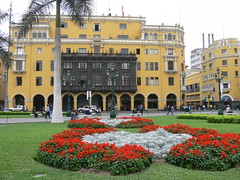Short stop in Lima
Lima with its 8-10 million habitats was a big change from the quiet days on sea at the Galapagos. Actually we were a little afraid if it would be too much, but fortunately Lima surprised us positively.
We found a nice hostel in the centre of the city close to the main square. The building had a great atmosphere with sculptures, old paintings and huge golden colored mirrors creating an idea of living in an old colonial mansion…well that is if you could abstract from the poor beds, the dirty walls and the not very neat common bathrooms.
From the hostel, we had great walks in a pleasant neighborhood with many small restaurants and colonial buildings and churches.
The main square only two blocks from the hostel is surrounded by the grandly governmental palace, the cathedral, the archbishop’s palace and other impressive colonial style buildings. In the evening the buildings are illuminated which makes the buildings look even more impressive.
We visited the San Francisco Monastery, which had the true atmosphere of a convent. You could almost feel the energy from the monks who used to walk around in the garden or in the numerous spectacular rooms clustered with old paintings and cider wood furniture.
Our favorite spot was the old library, which we are going to copy one day, with its tiny spiral staircases and tall walls containing thousands of books going back as far as the 16th century. The monks in the monastery must have used years after years studying all these books of mathematics, history, astronomy etc. Some of the books ‘paper’ was actually sheep skin!
Under the monastery are the more famous catacombs which contain bones and skulls of approximately 70.000 people who used to live in the area around the monastery and the attached cathedral. The bones and skulls are fully exposed and arranged in fine patterns and order, - quite macabre actually.
We also went to the National Museum which has the best displayed exhibition any of us have seen. The only problem was the lack of information. There doesn’t exist a guide to the exhibition, many things were poorly explained in Spanish and there was only little information in English.
But it was still worth seeing. The museum gave us a really good idea of the many great pre-Inca civilizations (Quechua Andean cultures) that existed in Peru, before the Incas grew big in the 14th century.
Peru has a big cultural inheritance that the Spaniards (and partly Incas) so effectively has almost eradicated in their hunger for gold, silver and power.
After just two nights in Lima, we felt like moving on and found a plane to Cusco – the Inca capital - where we will spend a little week adjusting to the heights before going on the 4-day Inca Trail trek.


0 Comments:
Post a Comment
<< Home